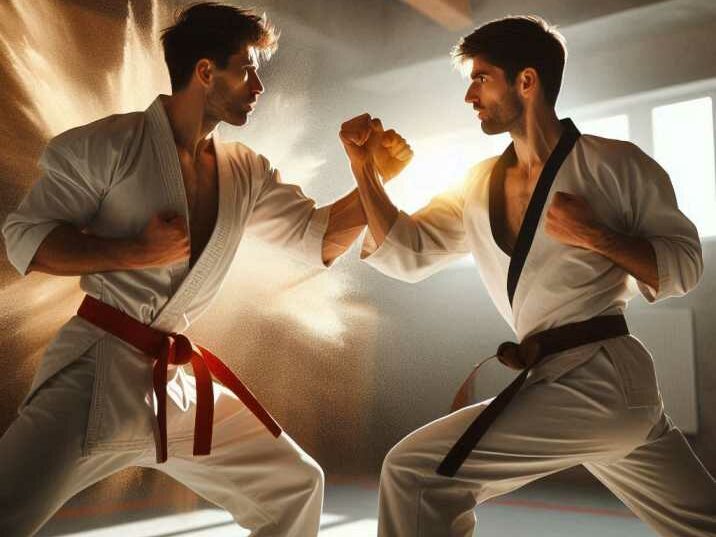When it comes to martial arts, “Karate vs. Taekwondo” often becomes a heated debate. Both disciplines offer unique benefits, training styles, and cultural histories. Whether you’re a parent looking to enroll your child in a martial art or an adult considering picking up a new hobby, understanding the differences between Karate vs.Taekwondo can help you make an informed decision.

Table of Contents
Table of Contents
- Introduction to Karate vs. Taekwondo
- Historical Background
- Key Differences in Techniques
- Training and Practice
- Belt Systems and Rankings
- Philosophies and Principles
- Health Benefits
- Competition and Sports
- Cultural Significance and Global Influence
- Choosing the Right Martial Art for You
- Conclusion
- Frequently Asked Questions (FAQs)
Introduction to Karate vs. Taekwondo
Karate and Taekwondo are two of the most popular martial arts worldwide. Both disciplines focus on self-defense, discipline, and physical fitness. However, they differ significantly in their techniques, philosophies, and origins.
Historical Background of Karate and Taekwondo`
Karate
Karate originated in Okinawa, Japan, and was influenced by indigenous Okinawan fighting styles and Chinese martial arts. The word “Karate” means “empty hand,” reflecting its focus on unarmed combat. It became popular in mainland Japan in the early 20th century and has since spread globally.
Okinawan Roots
Karate’s development was significantly influenced by the unique cultural and historical context of Okinawa. The island was a trading hub, where local martial arts blended with techniques from China and Southeast Asia. This cross-cultural exchange helped shape the diverse techniques and philosophies that characterize Karate today.
Taekwondo
Taekwondo, on the other hand, hails from Korea and has a more recent history. It was developed in the 1940s and 1950s by combining traditional Korean martial arts with influences from Karate. “Taekwondo” translates to “the way of the foot and hand,” highlighting its emphasis on high, fast kicks.
Post-War Development
After World War II and the Korean War, there was a strong push to develop a national martial art that would embody Korean culture and identity. Taekwondo emerged from this movement, integrating aspects of various Korean and Japanese martial arts. The formation of the Korea Taekwondo Association in 1959 helped standardize the practice and spread it internationally.
Key Differences in Techniques
Striking Techniques
In Karate, practitioners primarily use hand strikes, punches, and linear kicks. Techniques are designed to deliver powerful, precise blows to specific targets. Karate also incorporates knee strikes and elbow strikes.
Punching Techniques
Karate emphasizes strong, focused punches aimed at vital points on the opponent’s body. Techniques such as the “gyaku zuki” (reverse punch) and “oi zuki” (lunge punch) are fundamental. Practitioners train to deliver these punches with speed and accuracy, often using makiwara (striking boards) to develop power.
Kicking Techniques
Taekwondo, however, is renowned for its dynamic kicking techniques. High, spinning, and jumping kicks are a hallmark of Taekwondo. While it also includes hand strikes, the kicks are often more emphasized in training and competitions.
Specialty Kicks
Taekwondo’s repertoire includes spectacular techniques like the “tornado kick” and the “540 kick,” which are not only effective but also visually impressive. These kicks require significant agility and control, often becoming a focal point in demonstrations and competitions.
Stances and Movements
Karate stances are generally lower and more rooted, providing stability and power. Movements in Karate are often linear and direct, focusing on straightforward attacks and blocks.
Kata Movements
Kata, or forms, are a critical component of Karate. Each kata consists of a series of movements and techniques performed in a specific sequence. Practitioners memorize and perfect these katas, which serve as a method to practice and refine techniques, develop muscle memory, and preserve traditional martial knowledge.
Taekwondo Stances
Taekwondo stances are usually higher and more relaxed, allowing for greater mobility and the execution of rapid, complex kicks. The movements are more circular and fluid compared to the linear approach of Karate.
Poomsae Movements
Poomsae are the equivalent of kata in Taekwondo. These forms focus on both offensive and defensive techniques, performed with precision and rhythm. Practicing poomsae helps Taekwondo practitioners develop balance, coordination, and an understanding of the martial art’s underlying principles.
Training and Practice
Dojos and Dojangs
Karate is practiced in a dojo, which means “place of the way” in Japanese. Training focuses on kata (forms), kumite (sparring), and kihon (basic techniques).
Dojo Etiquette
Respect and discipline are central to the dojo environment. Students bow upon entering and leaving the dojo, as well as when addressing instructors or fellow students. This practice fosters a sense of humility and respect for the martial art and its traditions.
Taekwondo Practice
Taekwondo is practiced in a dojang, the Korean equivalent. Training includes poomsae (forms), sparring, and breaking techniques. The emphasis is on developing speed, agility, and flexibility.
Dojang Culture
Similar to the dojo, the dojang maintains a strict code of conduct. Practitioners bow to the flag and the instructor, and adherence to the tenets of Taekwondo is emphasized. This culture reinforces the importance of respect, discipline, and moral integrity.
Training Regimen
Both martial arts require discipline and consistent practice. Karate training often includes repetitive drills to perfect techniques, as well as strength and conditioning exercises.
Strength and Conditioning
Karate practitioners engage in rigorous physical conditioning to develop the strength and endurance needed for effective technique execution. This includes weight training, cardiovascular exercises, and flexibility training.
Flexibility and Agility
Taekwondo training, meanwhile, places a strong emphasis on flexibility and cardiovascular fitness. Practitioners often perform dynamic stretching and plyometric exercises to enhance their kicking abilities.
Dynamic Stretching
Dynamic stretching routines are integral to Taekwondo practice. These routines not only improve flexibility but also prepare the muscles for the explosive movements required in high-level kicking techniques.
Belt Systems and Rankings of Karate and Taekwondo
Both Karate and Taekwondo use a belt system to signify a practitioner’s progress and skill level. However, the specifics can vary between the two.
Karate Belt System
In Karate, the belt colors typically progress from white, yellow, orange, green, blue, brown, and finally to black. Each color represents a different stage of learning and proficiency.
Dan Rankings
Beyond the black belt, practitioners can achieve higher ranks, known as dan degrees. These rankings signify advanced expertise and a deep understanding of Karate’s principles and techniques. The path to higher dan ranks involves continuous learning, teaching, and contributions to the martial art.
Taekwondo Belt System
Taekwondo belts often follow a similar color progression but may include additional colors like red and purple. The final goal is also the black belt, with multiple degrees (dan) signifying higher levels of expertise.
Black Belt Levels
In Taekwondo, achieving a black belt is just the beginning. Higher dan levels are awarded based on years of practice, contributions to the art, and the practitioner’s ability to demonstrate advanced techniques and knowledge.
Philosophies and Principles of Karate vs. Taekwondo
Karate Philosophy
Karate emphasizes self-discipline, respect, and perseverance. The principles of Karate include “Dojo Kun” which are guidelines for behavior both inside and outside the dojo. These often include respect for others, striving for perfection of character, and the endeavor to excel.
Dojo Kun Principles
The Dojo Kun often includes five to seven principles that guide a practitioner’s conduct. These principles emphasize moral and ethical behavior, humility, and the continuous pursuit of self-improvement.
Taekwondo Philosophy
Taekwondo is guided by five tenets: courtesy, integrity, perseverance, self-control, and indomitable spirit. These principles aim to develop not just physical strength but also moral character. Practitioners are encouraged to apply these tenets in all areas of their lives.
Tenets in Practice
Each tenet of Taekwondo is integrated into daily practice. For example, courtesy involves showing respect to instructors and peers, while perseverance encourages practitioners to overcome challenges and continue improving their skills.
Health Benefits of Karate and Taekwondo
Physical Benefits
Both Karate and Taekwondo offer numerous physical benefits. They improve cardiovascular health, increase muscle strength, enhance flexibility, and boost overall fitness levels. Regular practice can also help with weight management and increase energy levels.
Cardiovascular Health
Engaging in martial arts training provides an excellent cardiovascular workout. The high-intensity drills, sparring sessions, and continuous movement help improve heart health and increase stamina.
Mental Benefits
Martial arts are not just about physical prowess; they also offer significant mental benefits. Practicing Karate or Taekwondo can improve focus, discipline, and self-confidence. Both arts teach respect for oneself and others, promoting a positive mental attitude and stress relief.
Stress Relief
The disciplined practice and physical exertion involved in martial arts training act as a stress reliever. Practitioners often find that the concentration required for techniques and forms helps them clear their minds and reduce stress levels.
Competition and Sports
Karate Competitions
Karate competitions typically include kata (form) and kumite (sparring). In kata competitions, practitioners perform a series of movements showcasing their skill and precision. Kumite involves sparring with an opponent, where points are scored based on technique and control.
Olympic Karate
Karate made its debut in the Olympics in 2021, featuring both kata and kumite events. This inclusion has helped raise the profile of Karate on the global sports stage, attracting more participants and spectators.
Taekwondo Competitions
Taekwondo is an Olympic sport and features both sparring and poomsae competitions. Sparring matches are dynamic and fast-paced, with points awarded for effective strikes to the opponent. Poomsae competitions involve performing a series of choreographed movements, judged on accuracy and expression.
Olympic Taekwondo
Taekwondo has been a part of the Olympics since 2000. Its inclusion has significantly boosted the sport’s visibility and popularity worldwide. Olympic Taekwondo focuses on full-contact sparring, with athletes showcasing their speed, agility, and strategic thinking.
Cultural Significance and Global Influence
Karate’s Cultural Impact
Karate has significantly influenced global culture, especially in the realms of media and entertainment. It has been popularized through movies, television shows, and even video games. Iconic figures like Bruce Lee and Chuck Norris have brought Karate into the mainstream, inspiring countless individuals to take up the art.
Media Representation
Karate’s portrayal in popular media often highlights its philosophical aspects and the journey of self-improvement. Movies like “The Karate Kid” have introduced millions to the martial art’s values and techniques.
Taekwondo’s Global Reach
Taekwondo’s inclusion in the Olympics has propelled its global reach and recognition. The sport’s international competitions attract practitioners from around the world, fostering a sense of global community and cultural exchange. Taekwondo is also a part of many school curriculums, especially in countries like South Korea.
International Competitions
Taekwondo’s global competitions, such as the World Taekwondo Championships and the Olympics, have helped promote cultural exchange and mutual understanding among participants from different countries.
Choosing the Right Martial Art for You
When deciding between Karate and Taekwondo, consider your personal goals and preferences. If you prefer hand strikes and a more traditional approach, Karate might be the right choice. If you’re drawn to dynamic kicking techniques and enjoy fast-paced movements, Taekwondo could be a better fit.
Personal Goals
Assessing your personal goals can help determine which martial art is best for you. Whether you seek self-defense skills, physical fitness, mental discipline, or a combination of these, understanding your motivations will guide your decision.
Visit Local Dojos and Dojangs
It’s also beneficial to visit local dojos and dojangs, observe classes, and talk to instructors. This firsthand experience can help you understand the training environment and choose the martial art that resonates with you.
Trial Classes
Many martial arts schools offer trial classes or introductory programs. Participating in these can provide a taste of what each martial art involves and help you make an informed choice.
Conclusion
In conclusion, the debate of “Karate vs. Taekwondo” isn’t about which martial art is better, but which one fits your personal goals and interests. Both offer rich histories, unique techniques, and valuable physical and mental benefits.
Karate emphasizes hand strikes, precise movements, and discipline, making it ideal for those who appreciate tradition and powerful, controlled techniques. Taekwondo focuses on dynamic kicks, agility, and high-energy movements, perfect for those who enjoy fast-paced, explosive action.
Whether your goal is to improve fitness, learn self-defense, or cultivate mental discipline, both Karate and Taekwondo offer rewarding paths. Visiting local dojos and dojangs, and trying classes, can help you choose the right one.
Ultimately, by choosing a martial art that resonates with you, you embark on a journey of personal growth, empowerment, and lifelong learning. Karate and Taekwondo each promise a unique and enriching experience, extending benefits far beyond the training mat.
Frequently Asked Questions (FAQs)
1. Which is better for self-defense, Karate or Taekwondo?
Both Karate and Taekwondo offer effective self-defense techniques. Karate focuses more on hand strikes and close-range combat, while Taekwondo emphasizes powerful kicks. The best choice depends on your personal preference and which techniques you feel more comfortable executing.
Practical Application
Self-defense effectiveness can also depend on the situation and how well the techniques are applied. Training consistently and understanding the principles behind the techniques will enhance your ability to defend yourself.
2. Is Taekwondo harder to learn than Karate?
The difficulty of learning either martial art depends on the individual. Taekwondo’s dynamic kicks can be challenging for some, while others might find Karate’s precise hand strikes difficult. Consistent practice and dedication are key to mastering either discipline.
Learning Curve
Both martial arts have a learning curve that requires patience and persistence. Finding a supportive training environment and an experienced instructor can make the learning process more enjoyable and rewarding.
3. Can I start learning Karate or Taekwondo as an adult?
Absolutely! Both Karate and Taekwondo welcome practitioners of all ages. Many dojos and dojangs offer classes specifically for adults, focusing on fitness, self-defense, and personal growth.
Age Considerations
Starting martial arts training as an adult can offer numerous benefits, including improved physical health, stress relief, and social interaction. Many adults find martial arts to be a fulfilling and lifelong pursuit.
4. How long does it take to earn a black belt in Karate or Taekwondo?
Earning a black belt typically takes several years of consistent practice. In both Karate and Taekwondo, it usually takes around 3-5 years, depending on the individual’s dedication and the specific requirements of the dojo or dojang.
Commitment and Progress
The journey to a black belt involves continuous learning, practice, and personal development. The time it takes can vary based on the individual’s commitment, frequency of training, and the curriculum of the martial arts school.
5. Which martial art is more popular in the USA?
Both Karate and Taekwondo are popular in the USA, with many schools and practitioners across the country. Taekwondo has a strong presence due to its inclusion in the Olympics, but Karate also enjoys widespread popularity and recognition.
Regional Preferences
The popularity of each martial art can vary by region and community. Exploring local schools and talking to practitioners can provide insight into which martial art has a stronger presence in your area.


